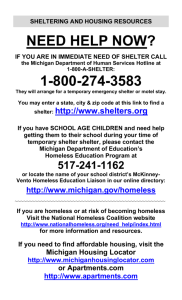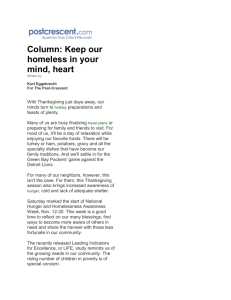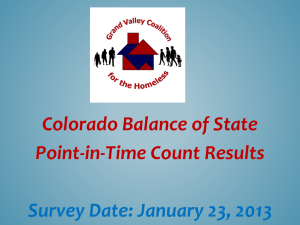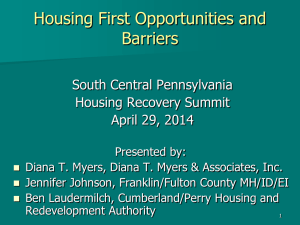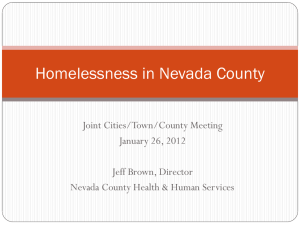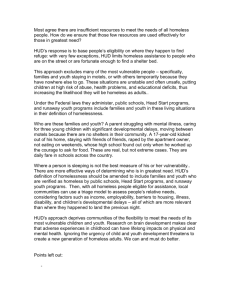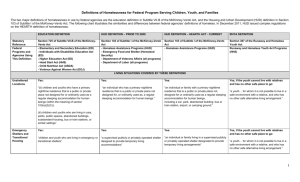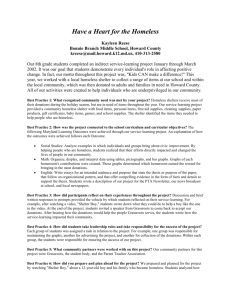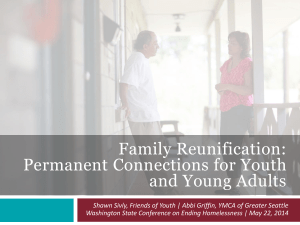Housing Definitions... - Bridges to Opportunity
advertisement
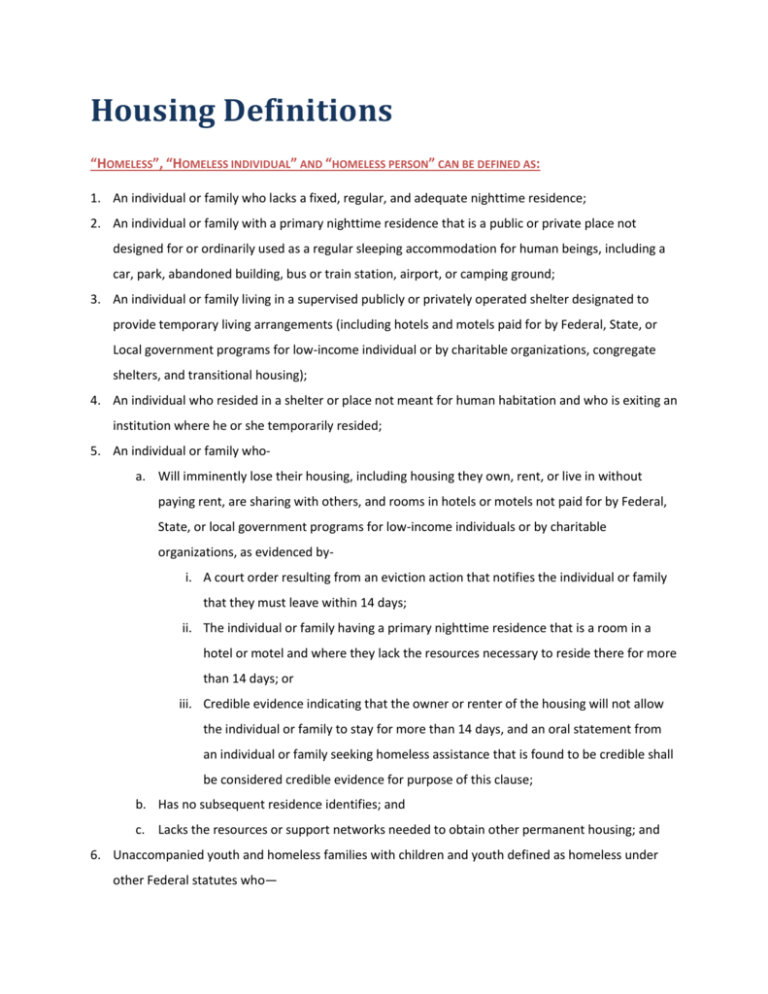
Housing Definitions “HOMELESS”, “HOMELESS INDIVIDUAL” AND “HOMELESS PERSON” CAN BE DEFINED AS: 1. An individual or family who lacks a fixed, regular, and adequate nighttime residence; 2. An individual or family with a primary nighttime residence that is a public or private place not designed for or ordinarily used as a regular sleeping accommodation for human beings, including a car, park, abandoned building, bus or train station, airport, or camping ground; 3. An individual or family living in a supervised publicly or privately operated shelter designated to provide temporary living arrangements (including hotels and motels paid for by Federal, State, or Local government programs for low-income individual or by charitable organizations, congregate shelters, and transitional housing); 4. An individual who resided in a shelter or place not meant for human habitation and who is exiting an institution where he or she temporarily resided; 5. An individual or family whoa. Will imminently lose their housing, including housing they own, rent, or live in without paying rent, are sharing with others, and rooms in hotels or motels not paid for by Federal, State, or local government programs for low-income individuals or by charitable organizations, as evidenced byi. A court order resulting from an eviction action that notifies the individual or family that they must leave within 14 days; ii. The individual or family having a primary nighttime residence that is a room in a hotel or motel and where they lack the resources necessary to reside there for more than 14 days; or iii. Credible evidence indicating that the owner or renter of the housing will not allow the individual or family to stay for more than 14 days, and an oral statement from an individual or family seeking homeless assistance that is found to be credible shall be considered credible evidence for purpose of this clause; b. Has no subsequent residence identifies; and c. Lacks the resources or support networks needed to obtain other permanent housing; and 6. Unaccompanied youth and homeless families with children and youth defined as homeless under other Federal statutes who— a. Have experienced a long term period without living independently in permanent housing, b. Have experienced persistent instability as measured by frequent moves over such period, and c. Can be expected to continue in such status for an extended period of time because of chronic disabilities, chronic physical health or mental health conditions, substance addiction, histories of domestic violence or childhood abuse, the presence of a child or youth with disability, or multiple barriers to employment. “AT RISK OF HOMELESSNESS” CAN BE DEFINED AS: 1. Has income below 30 percent of median income for the geographic area; 2. Has insufficient resources immediately available to attain housing stability; and 3. Has moved frequently because of economic reasons; a. Is living in the home of another because of economic hardship; b. Has been notified that their right to occupy their current housing or living situation will be terminated; c. Lives in a hotel or motel d. Lives in severely overcrowded housing; e. Is exiting an institution; or f. Otherwise lives in housing that has characteristics associated with instability and an increased risk of homelessness. “CHRONICALLY HOMELESS” CAN BE DEFINED AS: 1. Is homeless and lives in a place not meant for human habitation, a safe haven, or in an emergency shelter; 2. Has been homeless and living or residing in a place not meant for human habitation, a safe haven, or in an emergency shelter continuously for at least 2 year or on at least 4 separate occasions in the last 4 years; and 3. Has an adult head of household (or a minor head of household if not adult is present in the household) with a diagnosable substance use disorder, serious mental illness, developmental disability, post-traumatic stress disorder, cognitive impairments resulting from a brain injury, or chronic physical illness or disability, including the co-occurrence of 2 or more of those conditions. “PERMANENT HOUSING” CAN BE DEFINED AS: Community-based housing without a designated length of stay, and includes both permanent supportive housing and permanent housing without supportive services “TRANSITIONAL HOUSING” CAN BE DEFINED AS: Housing the purpose of which is to facilitate the movement of individuals and families experiencing homelessness to permanent housing within 24 months or such longer period as determined necessary. “PUBLIC HOUSING” CAN BE DEFINED AS: Establishments that provide decent and safe rental housing for eligible low-income families, the elderly, and persons with disabilities. Public Housing is managed by local housing agencies with funds that are given by the U.S. Department of Housing and Urban Development (HUD) “PRIVATELY OWNED SUBSIDIZED HOUSING” CAN BE DEFINED AS: Private apartments that receive financial assistance from HUD to provide offer reduced rents to lowincome tenants. “HOUSING CHOICE VOUCHER PROGRAM (SECTION 8)” CAN BE DEFINED AS: HUD funded vouchers that are awarded to low income families to find their own place using the voucher to pay for all or part of the rent.


